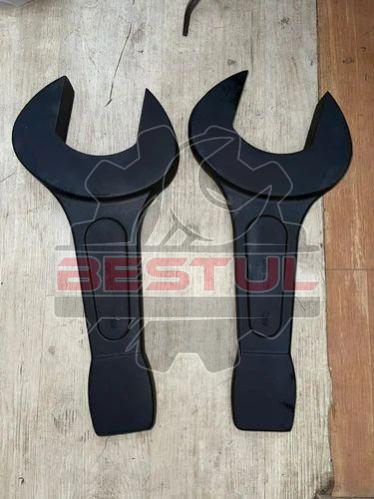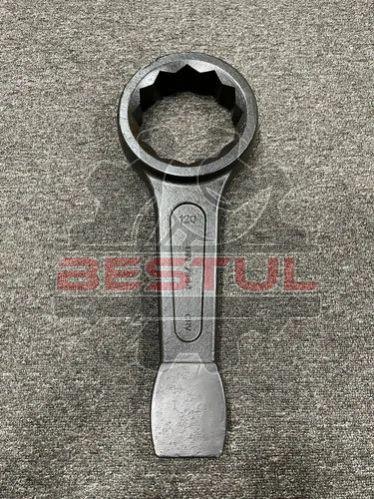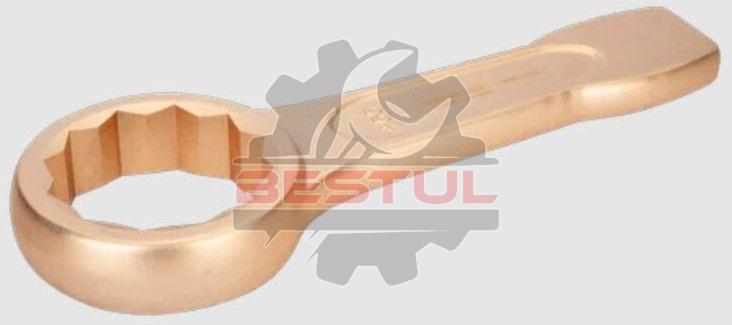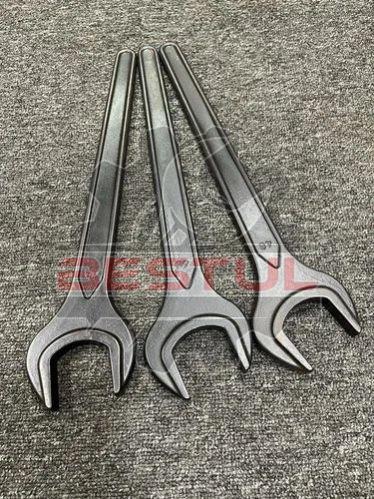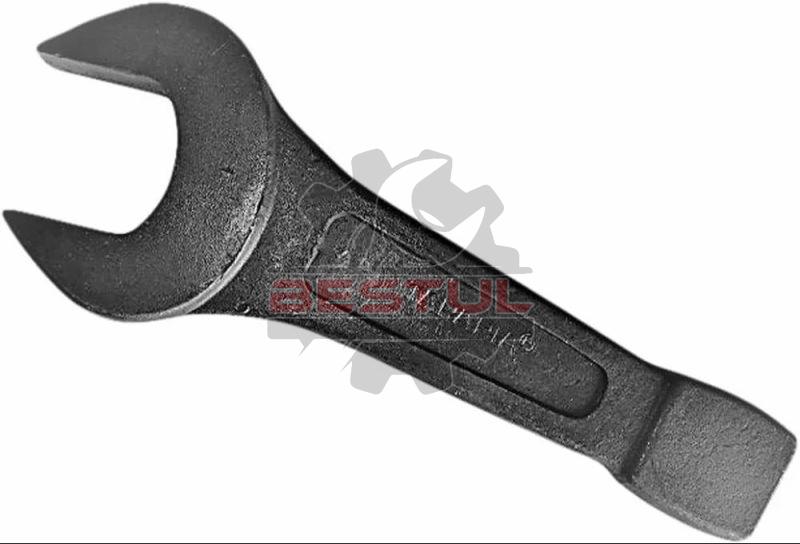| Business Type | Exporter, Supplier |
| Type Of Spanner | Single Ended Spanner |
| Size | 70MM |
| Measurement System | Metric, SAE |
| Color | Black |
| Warranty | 1 Year |
| Finishing | Black Finish |
| Usage | Bolt Tightening |
| Country of Origin | Made in India |
Slogging Open End SpannerIntroduction
A slogging open end spanner is a specialized hand tool designed for heavy-duty applications where significant torque is required. Unlike standard open-end wrenches, slogging spanners are built to withstand high-impact forces, making them ideal for use in industrial settings, construction, and automotive repair.
1. Definition and Purpose1.1 What is a Slogging Open End Spanner?
A slogging open end spanner features an open-ended jaw that grips the flat sides of a nut or bolt. The "slogging" aspect refers to its ability to be struck with a hammer or mallet, allowing the user to apply additional force and torque when loosening or tightening fasteners.
1.2 Key Uses
- Heavy Machinery: Used in industries such as mining, construction, and manufacturing to work with large bolts and nuts.
- Automotive: Ideal for loosening rusted or over-tightened bolts.
- General Maintenance: Effective in various maintenance tasks that require significant torque.
2. Design Features2.1 Material Construction
Slogging open end spanners are typically made from high-strength steel alloys. Common materials include:
- Chrome Vanadium Steel: Known for its strength and durability, this material offers excellent resistance to wear and tear.
- Chrome Molybdenum Steel: Offers superior strength and toughness, making it suitable for high-impact applications.
2.2 Jaw Design
The open end of the spanner is designed to fit snugly over nuts and bolts, usually with a specific angle to provide better access in tight spaces. The jaw's width and shape are critical for ensuring a secure grip.
2.3 Size Variability
Slogging spanners come in various sizes to accommodate different fastener dimensions. It's essential to select the correct size for optimal performance and to avoid damaging the fastener.
3. Advantages of Slogging Open End Spanners3.1 Enhanced Torque Application
The ability to be struck with a hammer allows for greater torque application compared to standard wrenches, making it easier to deal with stubborn fasteners.
3.2 Durability
Constructed from robust materials, slogging spanners are designed to endure heavy use without bending or breaking.
3.3 Versatility
These spanners can be used in a wide range of applications, from automotive repairs to industrial machinery maintenance.
4. How to Use a Slogging Open End Spanner4.1 Proper Technique
- Select the Correct Size: Ensure the spanner fits the fastener snugly to avoid rounding off the corners.
- Position the Spanner: Place the open end over the nut or bolt.
- Apply Torque: Strike the end of the spanner with a hammer to apply force. Use controlled blows to prevent damage.
- Loosen or Tighten: Continue to strike until the fastener loosens or tightens as needed.
4.2 Safety Considerations
- Wear Protective Gear: Always wear safety glasses and gloves when using slogging spanners.
- Secure Workpiece: Ensure that the workpiece is stable to prevent accidents during use.
- Use Appropriate Tools: Avoid using the slogging spanner for tasks it's not designed for, as this could lead to tool failure or injury.
5. Limitations and Considerations5.1 Weight and Bulkiness
Slogging spanners can be heavier and bulkier than standard wrenches, which may limit their use in tight spaces.
5.2 Cost
Due to their specialized nature and materials, slogging open end spanners can be more expensive than standard wrenches.
5.3 Potential for Damage
Improper use or excessive force can lead to damage to the spanner or the fastener, so it's crucial to use them correctly.
| Business Type | Exporter, Supplier |
| Type Of Spanner | Ring Spanner |
| Size | 32 mm |
| Packaging Type | Packet |
| Material | Carbon Steel |
| Measurement System | Metric |
| Finishing | Black Phosphate |
| Color | Black |
| Usage | Industrial |
| Warranty | Year |
Sledge Hammer Ring Spanner (7444SG)
Short profiled handle with heavy duty striking end. For heavy industrial applications and ideal for work in areas such as shipyards and the rail industry.
Ring ended
Forged Steel construction
Steel grey finish
| Business Type | Exporter, Supplier |
| Specialities | Non Breakable, High Quality |
| Type | Ring Spanner |
| Material | Cast Iron |
| Type Of Spanner | Ring Spanner |
| Packaging Type | Packet |
| Measurement System | Metric |
| Color | Golden |
A sparkless slogging ring spanner, also known as a spark-resistant slogging wrench, is a specialized tool designed for heavy-duty applications in environments where avoiding sparks is essential, such as in hazardous or explosive atmospheres. The term "slogging" refers to the use of a tool with a striking force, typically used with a hammer or mallet. Here’s a detailed overview of this tool:
Features and Design
-
Spark-Resistant Material:
- Material Composition: Made from non-ferrous materials such as beryllium copper or aluminum bronze, which are selected for their spark-resistant properties. These materials prevent the generation of sparks during use.
- Properties: Designed to minimize the risk of igniting flammable gases, vapors, or dust in hazardous environments.
-
Slogging Ring Design:
- Ring Head: The slogging ring spanner features a ring-shaped head designed to fit over nuts and bolts. The ring is typically a six-point or twelve-point design to provide a secure grip and reduce the risk of rounding off the fastener.
- Slogging Use: The tool is built to withstand the impact of being struck with a hammer or mallet, making it suitable for heavy-duty applications where high torque is required.
-
Construction:
- Strength and Durability: Constructed from robust, high-strength alloys to handle the stresses involved in heavy-duty applications. The tool is designed to be durable and long-lasting.
- Finish: Often treated to resist corrosion and wear, maintaining performance over time in demanding conditions.
-
Comfort and Ergonomics:
- Handle: The handle is designed for durability and may include features to enhance grip and control during use. Although ergonomics are less emphasized in slogging tools compared to precision tools, ensuring a comfortable grip can still be beneficial.
Applications
-
Hazardous Environments:
- Flammable or Explosive Atmospheres: Ideal for use in industries such as oil and gas, mining, and chemical processing, where avoiding sparks is crucial to prevent explosions or fires.
- Safety: Ensures that tools used in potentially dangerous environments do not generate sparks, enhancing overall safety.
-
Heavy-Duty Maintenance and Repair:
- Equipment and Machinery: Used for tasks that require high torque and where traditional wrenches may not be sufficient. The slogging spanner can handle tough, stubborn fasteners.
-
Industrial and Construction Work:
- Worksites: Suitable for construction and industrial applications where heavy-duty tools are needed and where spark prevention is important.
Usage Tips
-
Inspect Before Use: Regularly check the slogging spanner for any signs of damage, such as cracks or wear. Damaged tools should be replaced to ensure safety and effectiveness.
-
Proper Handling: Use the tool according to manufacturer instructions. The spanner is designed to be struck with a hammer or mallet, so use it with appropriate striking tools and techniques.
-
Storage: Store the spanner in a clean, dry environment to prevent corrosion and damage. Avoid exposure to harsh chemicals or extreme temperatures.
-
Cleaning: Clean the spanner with non-abrasive methods. Ensure that the tool is free from debris and contaminants that could affect its performance.
-
| Business Type | Exporter, Supplier |
| Type Of Spanner | Single Ended Spanner |
| Size | 32 mm |
| Model Name/Number | DIN 894 |
| Brand Name | Taparia |
| Packaging Type | Box |
| Material | Cast Iron |
| Finishing | Polished |
| Color | Silver |
| Technique | Hot Rolled |
| Usage | Automobile Industry |
- Made from high grade chrome vanadium steel
- Scientifically heat treated to give maximum strength and wear resistance
- Hardness: 40 – 50 HRC
- Slightly rounded handles-sand blasted –fit snugly in the hand and gives comfortable grip
- Good accessibility in confined spaces due to slim and practical design
- DIN 894 – ISO 3318
- Metric sizes from 6mm to 135mm forged from special tool steel and hardened to 120kg/mm² for high torque applications i.e. Construction, Heavy Industry, Railways, Shipyards, Mines, Farming, Oil rigs etc.
- Jaws ground precisely to exact size
- Extra long shaft for deep applications
- High Bending Strength: Spanner does not fracture or splinter when overloaded.
- Ergonomy: Profile designed for more efficiency, open end angled at 15°.
- Manganese-Phosphate finish with hanging hole.
| Business Type | Exporter, Supplier |
| Brand Name | Taparia |
| Type Of Spanner | Hammering Open |
| Packaging Type | Box |
| Material | Chrome Vanadium Steel |
| Measurement System | Metric, SAE |
| Color | Black |
| Country of Origin | Made in India |
A "slogging spanner" is a heavy-duty tool used for applying significant force to loosen or tighten bolts, typically in industrial or mechanical applications. It's designed to withstand heavy impacts from a hammer or mallet, hence the term "slogging," which implies using forceful blows to achieve the desired effect.
The term "slogging" suggests a certain level of brute force being applied to the task at hand. These spanners are often used in situations where bolts or nuts are heavily corroded or tightly stuck, requiring more force than a standard wrench can provide.
Slogging spanners usually have a robust construction to endure the impacts without deformation or damage. They come in various sizes to fit different bolt heads and are an essential tool in many maintenance and repair tasks, especially in industries like construction, automotive, and manufacturing.
